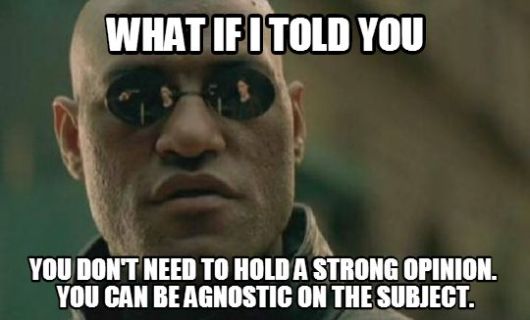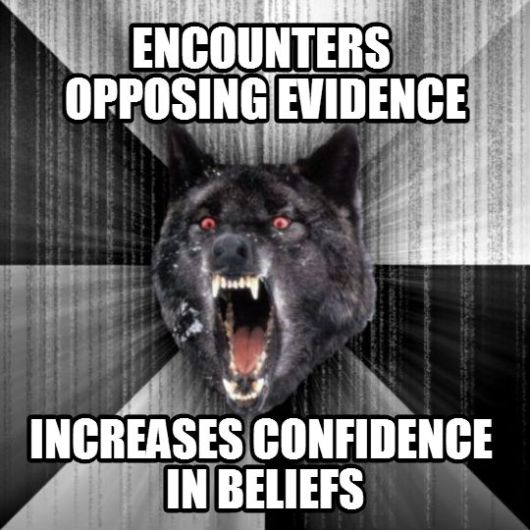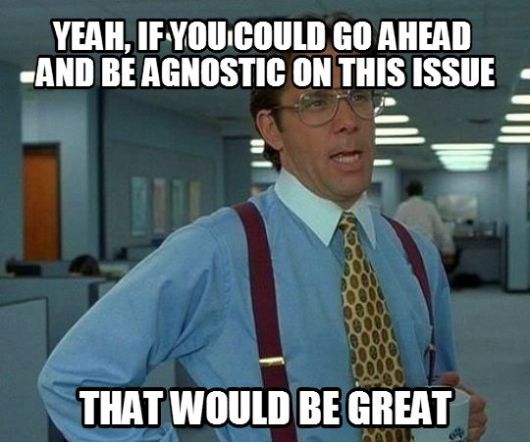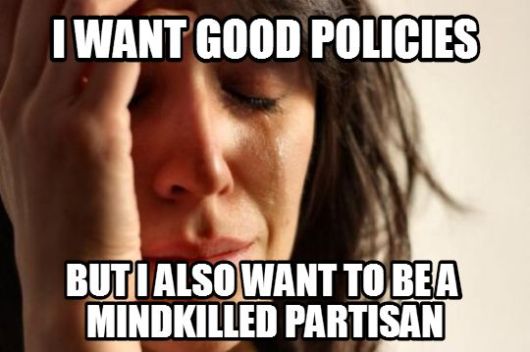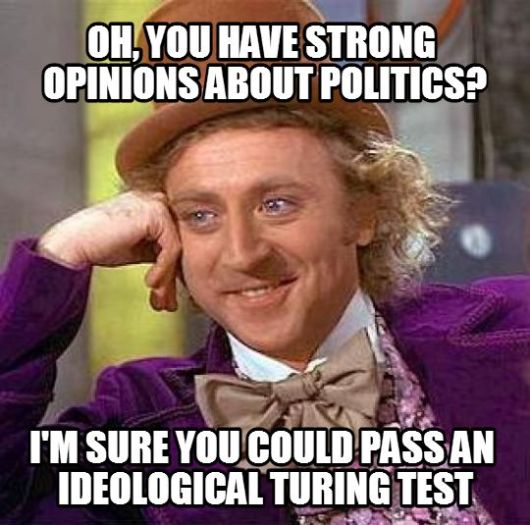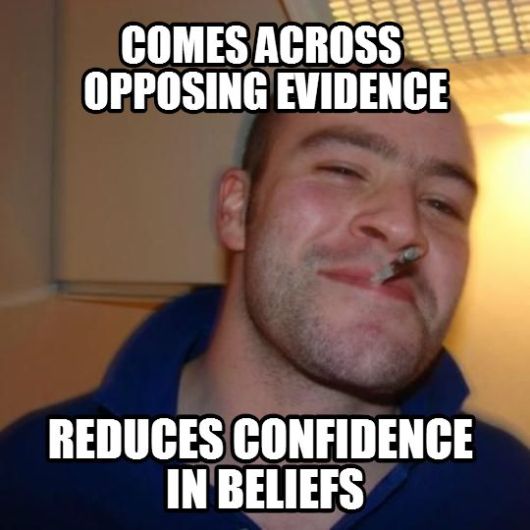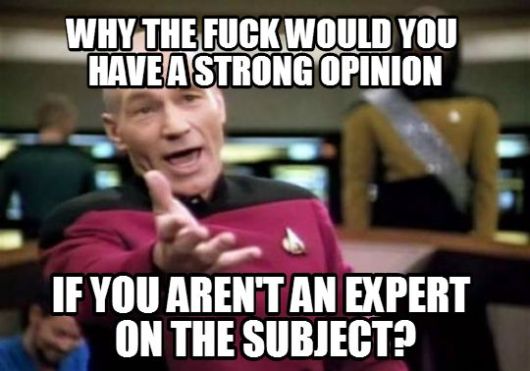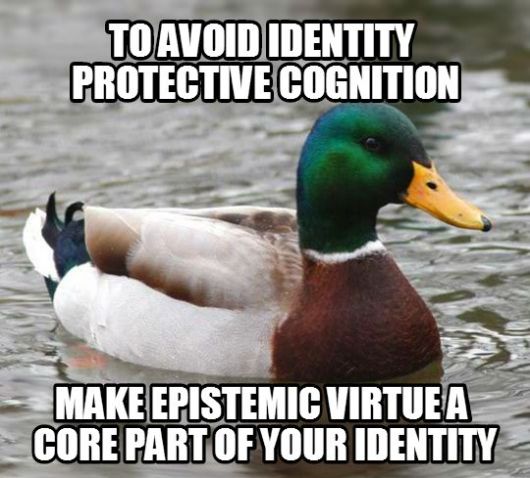Epistemic Rationality Memes
For those who love epistemic rationality and memes, here are my epistemic rationality memes, all in one place! Quick definition: Credence calibration means setting your degree of confidence in a belief to be proportional to the strength of the evidence. See the Credence Game for more.
Working Paper: “Legal Polycentrism and the Circularity Problem”
Here’s the working paper version of my previous posts on the circularity problem facing market anarchism: “Legal Polycentrism and the Circularity Problem.” Here’s the abstract:
Legal polycentrism studies the provision of security and dispute adjudication through competing protection agencies rather than a government monopoly. To show that competition between protection agencies would have beneficial consequences, polycentrists often cite results from price theory about market competition. But there is a circularity problem here: markets presuppose a legal framework; hence before polycentrists can employ price theoretic arguments about market competition, they must first show that the legal requirements of markets are satisfied, that is, that property rights and contracts are enforced. If these requirements are not satisfied, it is illegitimately circular to draw on market competition as an argument for legal polycentrism.
I’ve expanded upon and revised my argument, so check it out!
Notes and Fragments: Classical public choice is wrong
In this “Notes and Fragments” series I will briefly discuss some ideas that I might write about in more detail in the future. See Part I, Part II.
On the classical public choice view, “Politics is about concentrating benefits on well-organized and well-informed interest groups, and dispersing costs on the unorganized and ill-informed masses.” Since voters are rationally ignorant, they don’t pay attention to politics, and special interest groups determine policy against the wishes of the majority.
But there are problems with this story. Rational voters are not gullible; if special interests fund political advertising, rational voters would treat this information as biased and discount it accordingly. Even if ignorant voters have a small chance of catching politicians engaging in backroom deals with special interests, there is an easy solution: discipline politicians with optimal punishments. When politicians are caught misbehaving, punish them harshly to adjust for the small probability of apprehension. If voters are too uninformed to evaluate government programs, they can follow the rule: when in doubt, say no. On this account, rational ignorance leads to smaller government.
Furthermore, there are few examples of policies that are unpopular. As Caplan and Stringham argue, traditional examples of special interest activity like tariffs and pork barrel spending are in fact supported by a majority of voters. Foreign aid is unpopular, but is roughly 1% of the federal budget. Are there any other existing policies that the majority does not want?
These considerations should lead us to doubt that voters are actually rational. As Caplan argues, voters are rationally irrational: that is, it is instrumentally rational for voters to be epistemically irrational. The upshot is that although the arguments of classical public choice are false, most of the conclusions are still true.
See Caplan’s notes here and here, Caplan’s “Rational Irrationality and the Microfoundations of Political Failure,” Wittman’s “Why Democracies Produce Efficient Results,” Caplan’s Myth of the Rational Voter, and Wittman’s Myth of Democratic Failure.
Notes and Fragments: Boétie was wrong
In this “Notes and Fragments” series I will briefly discuss some ideas that I might write about in more detail in the future. See Part I.
Libertarians often cite Étienne de la Boétie to argue that government power depends on the consent or acquiescence of the governed. If government is outnumbered and outgunned by the mass of the population, then its power must depend on the voluntary support of the public. Hence governments can be toppled if enough people withdraw their support.
It seems to me that Boétie underestimated the severity of the collective action problems facing revolution: I benefit from the revolution whether I participate or not, and since participation is costly, I’m going to stay home. Suppose a majority of people do withdraw their support, and refuse to cooperate with the government. But the government has a military; if brutal enough, it could simply make an example out of a few resisters, thereby raising the costs of resistance and convincing everyone else to give up. So even though the government is outnumbered, what matters is not numbers but military strength, and the government military can defeat any uncoordinated mass uprising.
Hence I think it’s false that government power depends purely on ideology. (See also Jiborn’s “The Power of Coordination” and Caplan’s “Mises’ Democracy-Dictatorship Equivalence Theorem: A Critique.”)
Notes and Fragments: Roving bandits as tragic commons
In this “Notes and Fragments” series I will briefly discuss some ideas that I might write about in more detail in the future. This is Part I.
On Olson’s stationary bandit theory, a world of roving bandits is bad because no one has an incentive to produce or invest beyond subsistence level. A profit-maximizing bandit will therefore monopolize force in his domain, provide security, property rights, and public goods, thereby giving his subjects the incentive to produce and in doing so maximizing his income from tax receipts.
Olson is basically saying that if you view people like cattle, a world of roving bandits is an open-access commons, where resources (subjects) are wasted because no one can benefit from taking care of them. As a roving bandit, if I don’t plunder this village, someone else will; hence I plunder and we end up in the tragedy of the commons. Establishing a stationary bandit means privatizing the commons, where there is a residual claimant who can capture the benefits of using the resources efficiently (given a low discount rate). Hence, the stationary bandit theory is a special case of the tragedy of the commons.
Three Conceptions of the Burden of Proof
In rational discourse, the burden of proof is the obligation on a person to provide evidence for their position.
I. We might think that the burden of proof rests with the person asserting a claim. But consider:
(i) Suppose A asserts claim P, and afterwards, B asserts claim ~P. Under this conception, A bears the burden of proof.
(ii) B asserts claim ~P, and afterwards, A asserts claim P. In this case, B bears the burden of proof.
Except for the order of speaking, both cases are functionally equivalent; yet the burden switches from A to B. But surely the burden of proof does not depend on something as arbitrary as the order in which people speak.
One might object that both A and B bear the burden. This could be true sometimes. But sometimes only one of A or B bears the burden, and this conception fails to account for such cases. (For example, when P is the statement “The sky is blue.”)
II. A less naive conception is that the burden of proof rests with the person asserting a positive claim. But consider:
(iii) A asserts positive claim P, so that A bears the burden of proof.
(iv) A asserts negative claim ~(~P), so that A does not bear the burden of proof.
But since P and ~(~P) are equivalent, we have that A both does and does not bear the burden of proof. Since this is a contradiction, this conception must be flawed.
Now, it’s certainly true that the burden sometimes does rest with the person making the positive claim; if A claims that UFOs exist, then A bears the burden of proof. But there are easy counterexamples: if B makes the positive claim that the sky is blue, then surely the burden rests with those who would disagree.
III. The correct conception, it seems to me, is that the burden of proof is determined by common sense and expert consensus. If someone asserts a claim that contradicts common sense or expert consensus, then they bear the burden of proof. This conception captures what is correct in the other conceptions, and avoids their mistakes. For example, the person who claims that UFOs exist bears the burden of proof, not because it’s a positive claim, but because it contradicts common sense and expert knowledge. The person who would deny that the sky is blue bears the burden because they are contradicting common sense.
To be sure, common sense and expert consensus are imperfect. This is why the burden of proof is defeasible: if it turns out that common sense is defective, or if the experts are unreliable, then in those cases the burden has to be determined by other considerations.
In sum, simplistic formulas for determining the burden of proof are mistaken. Instead, establishing the burden requires making arguments and judgments about common sense and expert consensus.
Market Anarchism and the Circularity Problem
One common objection to market anarchism is the charge of circular reasoning: in attempting to explain how a market anarchist system would work, market anarchists illegitimately assume the enforcement of property rights and contracts, which is precisely what they need to prove. Hence Lee (2008):
Anarchistic libertarianism illegitimately and self-defeatingly presupposes the existence of contract law in its account of how law and its enforcement would come to exist and have an ongoing role in an anarchistic society. (18)
And Morris (1998):
To suppose, for the purpose of demonstration, that there exists a perfectly competitive market for protective services would be, in effect, to suppose that basic security of person and goods—at least that necessary for the existence of a perfectly competitive market for protective services—is already established. The argument would be circular. (65)
(See also Holcombe 2004, p.332.)
These critics seem to take this circularity problem to decisively refute, or at least create substantial doubts about market anarchism. While I don’t think circularity rules out the possibility of market anarchism, I do believe it is an important problem for market anarchist theory, and that solving it will require considerable revisions to the theory, especially with regards to the role of market competition.
Analytically, the market anarchist project involves endogenizing the legal system and deriving the market anarchist system as an equilibrium outcome. In other words, we start from the state of nature, or the “market for protection”: a context with no enforcement of property rights or contracts. From this setting, the task is to show how anarchist legal institutions could emerge and persist. This means that it is invalid to assume that property rights are enforceable, or to assume the existence of institutions or mechanisms (such as market competition) which presuppose enforcement of property rights.
The circularity problem
Market anarchist theory puts a heavy analytical burden on market competition to show that market anarchism would have good consequences. Roderick Long (2008) argues that market competition provides a stronger constitutional constraint on power than any governmental constitution. This is because of the standard benefits of competition: producers must sell a product that consumers are willing to purchase; unsatisfied customers can take their business elsewhere; new competitors can enter the market and attract away customers; and firms that satisfy customers earn profits while firms that do not incur losses. Hence market competition provides a powerful constraint on the ability of protection agencies to use force. In law as in everything else, competition beats monopoly.
Note, however, that this argument runs into the circularity problem: since market competition presupposes enforceable property rights, the argument implicitly assumes a legal structure. But this is exactly what the market anarchist project must show, namely, how an anarchist legal structure could arise. When we analyze normal markets, we assume a legal framework, i.e., enforcement of property rights and contracts. Standard economic theory has worked out in detail what will happen in this institutional setting. In contrast, in the market for protection, we explicitly assume the absence of a legal framework; we want to derive enforcement of property rights as an equilibrium outcome. Hence, since market competition presupposes a framework of law, it doesn’t make sense to talk about competition in the market for protection as if it were the same as competition in normal markets. More formally:
- When treating the legal system as endogenous, enforcement of property rights is an equilibrium outcome to be derived, not a starting assumption.
- Market competition presupposes a framework of law, and especially enforcement of property rights and contracts.
- Hence, from 1 and 2, when treating the legal system as endogenous, market competition cannot be used to explain how enforcement of property rights is an equilibrium outcome.
In other words, without some reasons to think that competition in the market for protection works like it does in normal markets, appeals to market competition are illegitimately circular. (It seems obvious to me that competition in the absence of enforceable property rights and contracts does not work the same as competition in the presence of these things.) Long’s constitutionalist argument would work if it could be shown that competition in the market for protection has the same nice properties as competition in normal markets. But again, to avoid circular reasoning, this task must be accomplished without appealing to market competition.
But what about Long’s claim (141) that “a functioning market and a functioning legal order arise together; it’s not as though one shows up on the scene first and then paves the way for the other”? I disagree. If we take the chicken and egg question, it seems to me that law comes first. Consider a state of nature: as Friedman (1994) argues, individuals could establish, without a state, at least limited property rights in possessions and land. This de facto law is the basis for market exchange, which then allows the development of more advanced legal institutions, which in turn fosters further market expansion, and so on in a virtuous circle. Hence I would define markets so that they presuppose a legal structure, which implies that law cannot be produced by the market.
(One might object: if some property rights can arise in the state of nature, why can’t competition be based on that? I agree that some beneficial competition could emerge; but this isn’t enough to warrant drawing on the strong results about normal market competition, as Long does. Regardless, this is a crucial question for future research: how does market competition work with imperfect property rights?)
None of this means that it’s impossible for an anarchist legal system to emerge in the market for protection (i.e., the state of nature); it just means that attempts to show this by appealing to market competition are invalid. The fact that a market presupposes a legal system does not rule out the possibility of a polycentric legal system.
Implications
Although the circularity problem does not mean market anarchism is impossible, I think it does show that the dominant approach to market anarchism is the wrong way to think about the issue. Up to now, most (all?) theorists have conceptualized market anarchism as privatizing the legal system, privatizing the police and courts, or turning the legal system over to the market. But due to the circularity problem, I think these approaches are incoherent: since the market presupposes a legal framework, it doesn’t make sense to talk about having the legal framework produced by the market. In general, any analysis of the market for protection that simply assumes that competition works like it does in normal markets is invalid.
What about David Friedman’s theoretical approach (e.g., Friedman 1996)? In principle, it is sound: assume an institutional setting, then derive the equilibrium. But it seems he too runs into the circularity problem. He beings his analysis as follows: “Imagine a society with no government. Individuals purchase law enforcement from private firms.” But the very act of “purchasing” requires that contracts are enforced, which in turn requires some pre-existing legal system, which is precisely what he needs to show. Maybe Friedman can show that these contracts would be self-enforcing, or that some other legal institution could enforce them, but until he does, his analysis fails to get off the ground.
So how should we think about market anarchism? I think a better approach to the question of anarchy vs. government is: the organization of violence in society. Here, market anarchism is just a polycentric organization of violence, whereas government is a monocentric organization of violence. Instead of viewing the anarchism debate as government vs. markets or monopoly vs. competition, see it as monocentric vs. polycentric organizations of violence. This approach avoids the circularity problem and allows us to get at the central issue: the properties of competition in the market for protection, or in other words, the properties of competition under imperfect property rights.
This approach is already being developed by the economics of conflict (see Bates et. al., 2002; Hirshleifer, 1995; Humphrey, 2010; and Konrad and Skaperdas, 2010). In this literature, the standard story is that unorganized violence is bad, but organized violence can be socially beneficial. Under unorganized violence, where all individuals use violence to defend property rights, the security of property claims depends on each individual’s ability to use violence to protect their property. Each individual must invest resources away from production and towards protection, which undermines the division of labor. Adding in the effects of the uncertainty of property claims and the possibility of violent conflict, unorganized violence appears to be wholly unsuitable for promoting economic prosperity.
In contrast, organized violence can be efficient if violence is used to protect property rights, and not for predation. Think of Olson’s stationary bandit, who has an incentive to provide security and enforce property rights in order to maximize his tax revenues. By having a specialist in violence, individuals can specialize in production, allowing an extended division of labor and thereby prosperity.
It seems to me that market anarchists can and should engage this literature on the question: which form of organized violence is best? As noted above, market anarchism is equivalent to a polycentric organization of violence. If anarchy is superior to the state, then it must be shown that a polycentric organization of violence is better than a monocentric one.
Bibliography
Bates, Robert, Avner Greif, and Smita Singh. (2002). “Organizing Violence.” Journal of Conflict Resolution, 46(5): 599-628.
Friedman, David D. (1994). “A Positive Account of Property Rights.” Social Philosophy and Policy, 11(2).
Friedman, David D. (1996). “Anarchy and Efficient Law.” In Sanders and Narveson (Eds.), For and Against the State.
Hirshleifer, Jack. (1995). “Anarchy and its Breakdown.” Journal of Political Economy, 103(1): 26-52.
Holcombe, Randall. (2004). “Government: Unnecessary but Inevitable.” Independent Review (3): 325-342.
Humphrey, Shawn. (2010). “Political Economy of Violence.” In Rhona Free (Ed.), 21st Century Economics: A Reference Handbook.
Konrad, Kai and Stergios Skaperdas. (2010). “The Market for Protection and the Origin of the State.” Economic Theory.
Lee, John Roger. (2008). “Libertarianism, Limited Government, and Anarchy.” In Long and Machan (Eds.), Anarchism/Minarchism: Is a Government Part of a Free Country?
Long, Roderick. (2008). “Market Anarchism as Constitutionalism.” In Long, Machan (Eds.) Anarchism/Minarchism: Is a Government Part of a Free Country?
Morris, Christopher. (1998). An Essay on the Modern State.
Against Rights Profligacy
The system of free markets and free enterprise is based on the right not to be aggressed against. This right, also known as the nonaggression principle, implies rights against assault, theft, and fraud. In a setting where these rights are enforced and protected, markets work well, and the foundation for economic prosperity is laid.
But some people are not satisfied with the distribution of wealth in a market system. They advocate for government to enforce a wide array of positive rights to promote social justice. It is claimed that we all have a right to a job, a right to health care, a right to welfare, a right to education, a right to food and water, and so on. And it is the responsibility of government to ensure that these rights are respected.
I want to argue against this “rights profligacy”. We should be much more frugal in deciding what counts as a right, because rights legitimate violence and violence is usually justified only in defense. Making an error about what is or is not a right entails using violence against innocent people. By unpacking precisely what it means to have a right to a job or a right to health care, I will show that this conception of rights—we have a right to anything that is valuable—clashes forcefully with our commonsense morality.
First I will make some remarks about the nature of rights. Having a right to X implies that (1) it is morally obligatory for other people to provide you with X; and (2) it is morally permissible for you to force other people to provide you with X. Hence having a right not to be aggressed against implies both that other people are obligated not to aggress you and that it is permissible to force other people not to aggress against you.
It is important to note that a right is a legitimately enforceable claim; since it is permissible to use coercion to enforce one’s rights, a right is the strongest type of moral claim. There are also weaker moral claims which are not enforceable. For example, I might have a duty to be grateful to my benefactors, but they do not have a right, an enforceable claim, to my gratitude. Also note that the importance of a moral claim does not necessarily correlate with its enforceability. Just because a right is enforceable does not mean it is morally more weighty than an unenforceable claim.
Two of the most common positive rights asserted in the name of social justice are the right to a job and the right to health care. By unpacking these rights using the definition above, I will show that what seems intuitively appealing on the surface in fact leads to repugnant and outrageous conclusions.
Consider the claim that people have a right to a job. More formally, this means that other people have an obligation to provide you with a job, and that it is permissible for you to force other people to give you a job. In other words, it is permissible to use or threaten violence to force other people to employ you.
In practice, this means forcing an employer at gunpoint to hire you, or using violence to prevent other workers from competing with you in a job interview, or even forcing a worker to hand over her job to you—”your job or your life.”
Clearly almost everybody would agree that forcing an employer to hire you at gunpoint is very wrong. It is a serious violation of the employer’s freedom of association. Employment should be consensual: both the employer and employee must consent for the contract to be legitimate. Anything less than full consent seems morally equivalent to slavery.
Once we unbundle what is means to have a right to a job, we see that what on the surface seems benign and progressive actually turns out to be monstrous and barbaric. Since rights legitimize violence, careless proposals for rights can lead to horrific outcomes.
Now let us unpack the claim that people have a right to health care. Formally, such a right means that other people have an obligation to provide you with health care, and that it is permissible to force others to provide you with health care. In practice a right to health care means forcing a physician at gunpoint to provide medical treatment, or forcing a pharmacist at gunpoint to to provide you with medicine.
Again, almost everybody would agree that obtaining health care at gunpoint violates the liberty of the physician and the pharmacist. Just as the patient should be able to choose her physician, the physician should be able to choose his patient. Otherwise, we face “the absurdity of physicians being at the personal beck and call of individual patients, becoming literally their medical slaves”. (Szasz) (In emergencies, it might be permissible to force a physician to provide treatment. But here I am abstracting from such cases and focusing on ordinary medical treatment.)
Just as with a right to a job, once we unbundle what it means to have a right to health care, what seems on the surface to be goodhearted and caring in fact has awful and outrageous implications.
It may be the case that people still have a moral claim to a job or health care. But obviously such a moral claim cannot have the strength of a right. Rather, it must be weaker than a right, which means it cannot be enforceable through violence. We might think a claim to a job is morally important, but making it enforceable has morally unacceptable implications.
Randy Barnett writes that the “rights that define justice serve also to legitimate the use of force or violence to secure compliance. The more rights we recognize the more violence we legitimate.” (The Structure of Liberty, 200; emphasis in original) Hence we have to be very careful in deciding what counts as a right, since making a mistake is very costly: initiating violence against innocent people. There are two types of errors: recognizing too many or too few rights. These errors correspond respectively with rights profligacy and rights frugality.
Given that many people want to create rights to solve any social problem that is deemed serious enough, the problem of rights profligacy is much more common. Most people err in the direction of trying to grant too many rights, rather than too little. In response, defenders of free markets should call for rights frugality to correct this overrecognition of rights. Given that rights legitimate violence, we should only recognize rights when a social problem cannot be solved in any other way.
Of course, the proper solution is to seek a golden mean of neither too few nor too many rights. This requires that we be very careful and painstaking in deciding on what should count as a right. Rights are not trivial things to be handed out casually; rather, since they legitimate violence, rights are a gravely serious matter. Those who call for government to promote social justice by creating a right to a job or a right to health care are too quick to use violence to solve social problems.
The Underpants Gnomes Theory of the State
You might be familiar with the underpants gnomes business plan from South Park:

It occurred to me that the prisoners’ dilemma (PD) justification of the state has a similar logic. The traditional story says that life in the state of nature is a PD, where everyone has the incentive to cheat rather than cooperate. But since everyone would be better off cooperating, they have an incentive to form a government that forces them to cooperate. Or, the underpants gnomes theory of the state:
1. People in the state of nature would benefit from establishing a government.
2. ???
3. Therefore, government.
What this justification skips over is an explanation of how people could establish a government. Government is treated as a deus ex machina, an “external” institution that is simply “given.” The traditional story throws rational choice out the window: instead of resulting from individual actions, government just magically pops into existence when its total social benefits outweigh total social costs.
(The absence of an explanation of the emergence of government from a PD game is quite puzzling when you think about it, since it’s not obvious how players in a PD could cooperatively set up a government when defecting is the dominant strategy.)
Jason Briggeman, in his paper “Governance as a Strategy in State-of-Nature Games,” (ungated) sets out to remedy this situation by providing the beginning of a rational choice model of the establishment of government. He creates a modified PD game, what he calls the “Prisoners’ Dilemma with Coercion,” where players have the option to adopt a coercive strategy and impose a strategy choice on another player.
As he writes: “To model this Hobbesian situation with the tools of game theory, it would seem to be required that society’s governor be an internal player who chooses strategies, not an external model-builder who sets payoffs.” It strikes me as odd that, given the widespread belief in the necessity of the state, something as important as a rational choice explanation for the emergence of government could have been ignored for so long.
